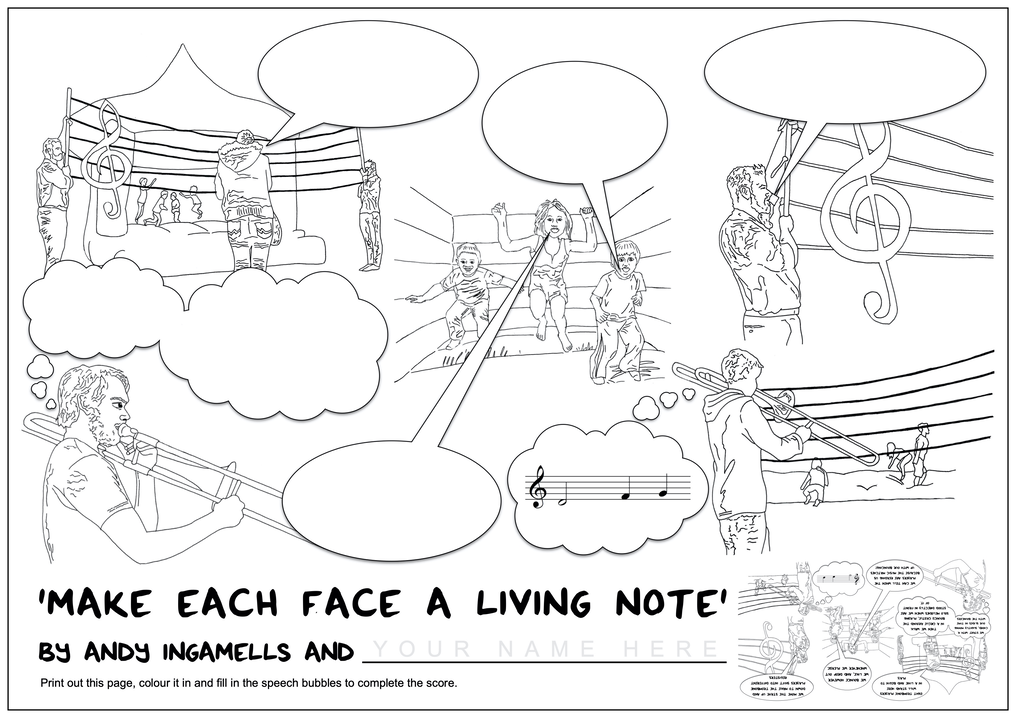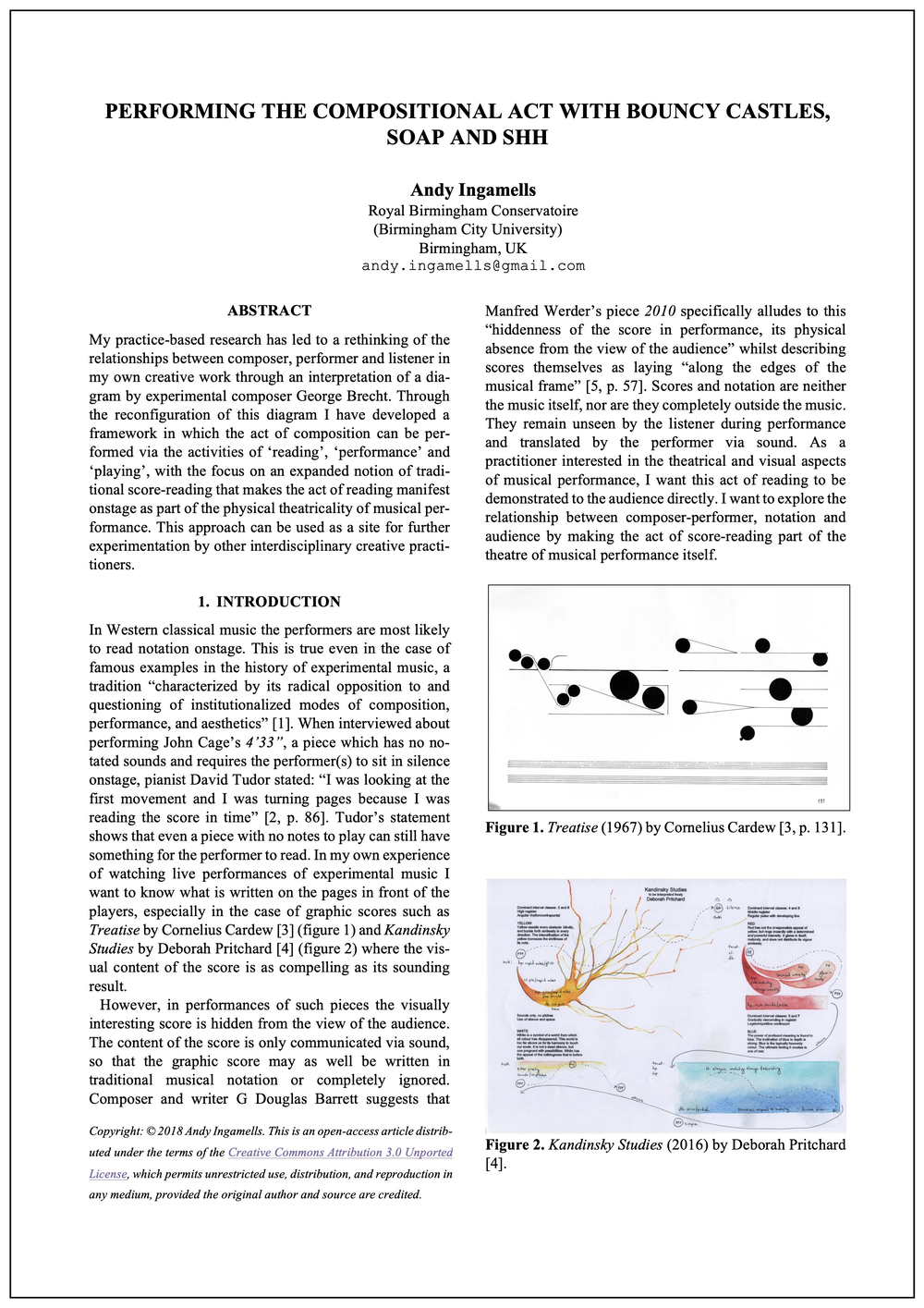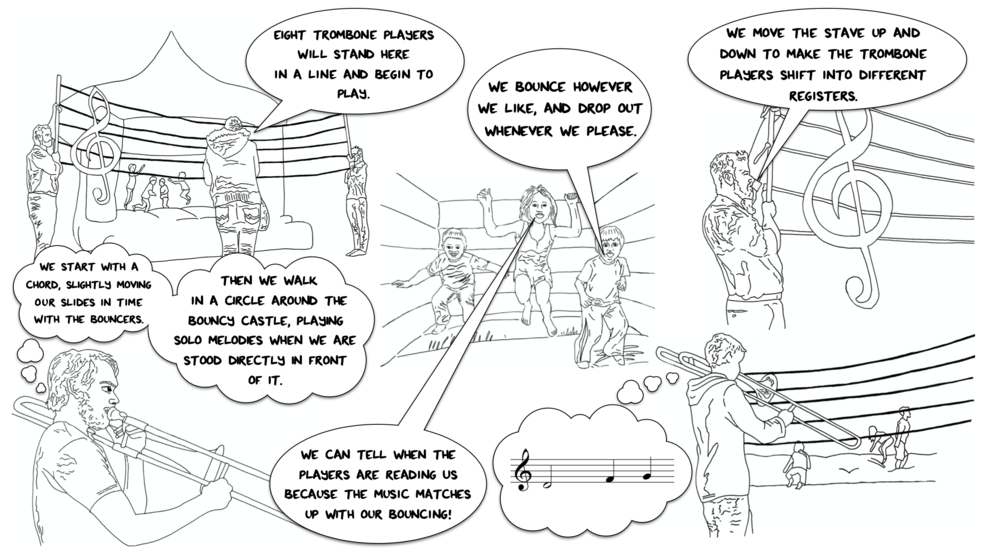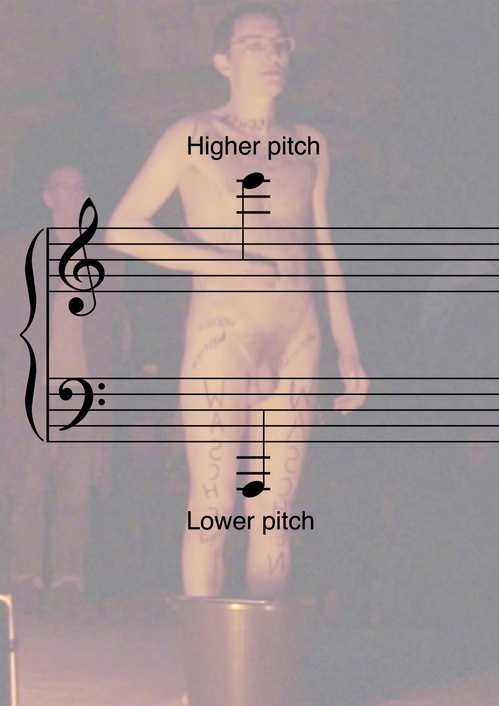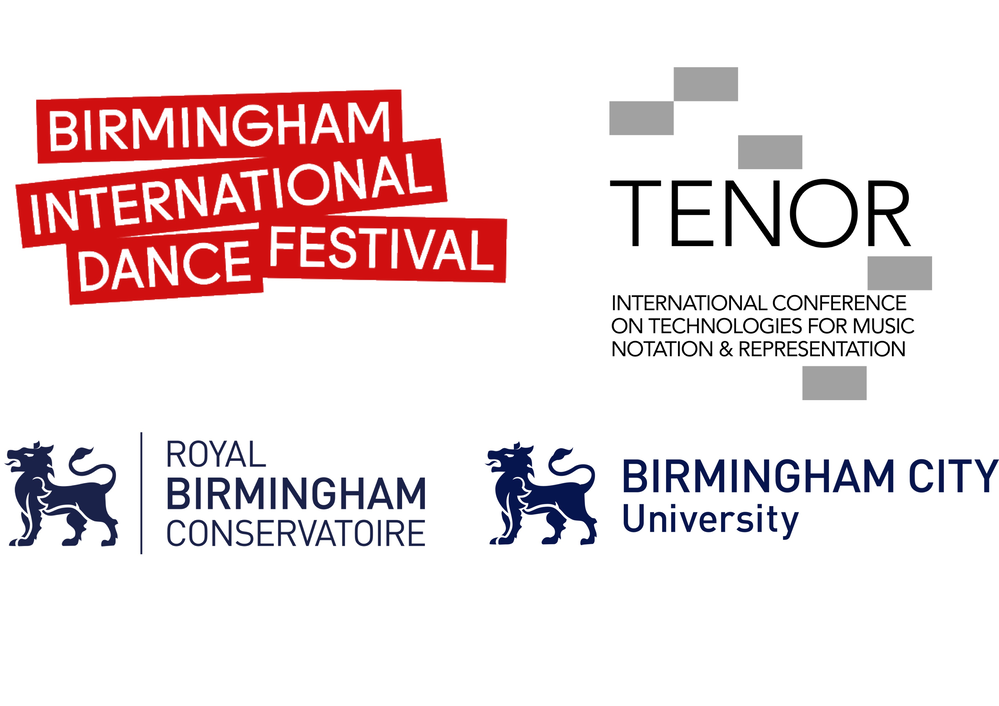CLICK TO OPEN – Make each face a living note (2018) – single page instructional graphic score in the style of a children's colouring sheet. Click on images within the score to hear audio excerpts from the performance.
CLICK TO PLAY – Make each face a living note (2018) – 1-minute video excerpt documenting the live performance
Summary of the research
The three creative works presented in this exposition are practical examples of ways in which notation can be reframed to become an integral part of the physical theatre of a musical performance. This act of reframing is presented as part of a process of reimagining relationships within musical performances through an interpreatation of a diagram by Fluxus composer George Brecht (1926–2008). In these three works the act of reading is integral to the theatre of musical performance. The creative outcomes are:
- Shh (2014) – a one-minute audio-visual work
- Waschen (2015) – a performance of indeterminate duration documented by a 9-minute video
- Make each face a living note (2018) – a performance of indeterminate duration with a graphic score, documented by a 1-minute video
This exposition provides contextual information to support the three creative outcomes.
Conference paper
This paper provides:
- detailed commentary on the three creative outcomes (sections 3.1, 3.2 and 6);
- contextual information about graphic scores and their relationship to composition (sections 1 and 2);
- contextual information about Fluxus and George Brecht's diagram (sections 4 and 5).
The paper was presented at TENOR International Conference on Technologies for Music Notation and Representation at Monash University in July 2019 and published in the conference processedings following peer-review.
CLICK TO OPEN – Performing the compositional act with bouncy castles, soap and shh (2019). Also available from the following link:
https://www.tenor-conference.org/proceedings/2019/07Ingamells.pdf
CLICK TO ENLARGE – Detail from bottom right-hand corner of graphic instructional score for Make each face a living note (2018), showing a suggestion for a possible performance.
CLICK TO ENLARGE – Front cover for the published version of the score for Y-E-S#13 (online publication, 2018)
3 – Make each face a living note (2018)
See section 6 of the conference paper for detailed commentary on this piece.
In Make each face a living note a large white bouncy castle is presented as though it is a musical score that is to be read and performed live in a participatory outdoor performance by an assembled group of brass players. The people bouncing on the bouncy castle, who could be considered the ‘audience’, are read as musical notation, and a 5-line musical stave is held in front of them using thick coloured rope. Passers-by are invited to become a unique part of an ever-changing musical score by bouncing on the castle while the musicians interpret their heads as musical notes. By presenting the audience as the notation to be read by the players in real time the piece challenges the traditions of what a musical and choreographic performance can be.
I created a graphic instructional score for the piece retroactively by making drawings using footage from the performance. It is presented in the style of a children’s colouring sheet with empty speech bubbles that leave room for different groups of musicians to significantly reinterpret the performance. A suggestion for a possible performance is provided in the bottom right-hand corner (reproduced below):
1 – Shh (2014)
See section 3.1 of the conference paper for detailed commentary on this piece.
In Shh I intervene in a radio broadcast by repeating a single vocal sound to change the meaning of a phrase. I achieve this by cropping together all the occurrences of the ‘Hit Music’ identifier on British commercial radio station CapitalFM during a typical hour-long broadcast to make a 1-minute audio track, then saying ‘shh’ every time the identifier appears in order to blur the two sounds and create the phrase ‘shit music’. The piece was originally conceived as a video work but is now often performed live. The pre-recorded track serves the purpose of an audio score that is used to indicate when the ‘shh’ sound should be made. In my performance I follow this audio track in the same way that a score of written musical notes would be followed. What I realised from Shh was that the score, in this case a backing track, can be the source of aesthetic experience in the performance. The score is the primary musical material, and my reading of the score through the synchronisation of the ‘shh’ sound serves as the reason to play it.
2 – Waschen (2015)
See section 3.2 of the conference paper for detailed commentary on this piece.
I perform Waschen as a solo, untrained singer, and read my body in a mirror, with the image of my body serving as musical notation to be read in real time. The word ‘waschen’ is written all across my body with thick black marker pen. The words serve the purpose of written music notation as something to be read onstage during a performance. As I perform the piece I take a bar of soap and wash the words from my body whilst reading aloud the words in a mirror. When I touch a particular part of a word I sing it, reading my body as though it is a musical stave, shown below in diagrammatic form:
Live performances of the works
Shh
27 October 2014, Birmingham Conservatoire
30 October 2014, Bastard Assignments, London
5 March 2015, Library of Birmingham
28 July 2015, Del Rex, Berlin
30 April 2016, Nexus Art Cafe, Manchester
17 January 2018, Nonclassical, London
10 May 2018, IKLECTIK, London
17 June 2018, Pumphouse, Aldeburgh
3 December 2018, Royal Northern College of Music
11 December 2019, Zolala, An Siopa Gan Ainm, Cork
Waschen
19 April 2015, Bastard Assignments, Asylum and Maverick Projects, London
13 July 2017, King’s College London
17 June 2018, Pumphouse, Aldeburgh
3 December 2018, Royal Northern College of Music, Manchester
11 December 2019, Zolala, An Siopa Gan Ainm, Cork
Make each face a living note
16 June 2018, Birmingham International Dance Festival
Commission information
Waschen was commissioned by Bastard Assignments: a composer-performer collective who organise performances in London and show work across the UK and internationally. They have been featured in articles and profiles in the Guardian, the Telegraph, Neue Zeitschrift für Musik and The Wire magazine.
Make each face a living note was commissioned by Birmingham International Dance Festival’s Midlands Made programme following a highly competitive application process and was supported by West Midlands Railway and Dance Hub Birmingham, receiving £3500 in funding.
Writing
The paper 'Performing the compositional act with bouncy castles, soap and shh' was published in the Proceedings of the International Conference on Technologies for Music Notation and Representation (TENOR). This followed a presentation of the work at the annual conference at Monash University in Melbourne, Australia in July 2019.
Waschen has been written about in ‘Colourful interactions: Composers, theatrical scores and music as performance’ by Louis d’Heudieres in Collaborative and Distributed Processes in Contemporary Music-Making, edited by Richard Glover, Lauren Redhead (2018, page 13).
The score and contextual information for Make each face a living note were published online for the 13th edition of Y-E-S in 2018 (www.Y-E-S.org).
